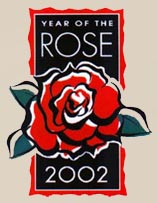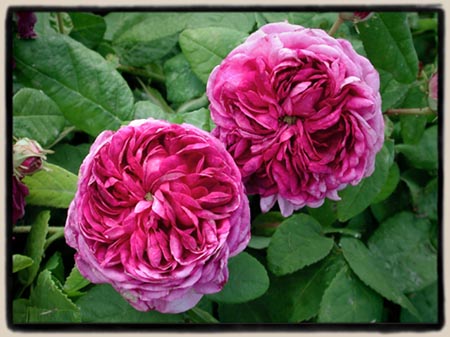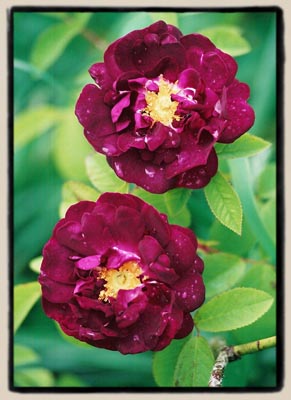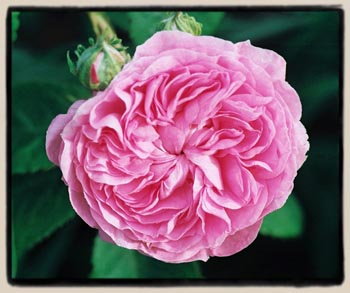 |
|
Albas |
Editor's note: I have decided this month to dedicate the feature article to a piece written by my friend Alice Flores on the topic of classification of the Genus Rosa. There has been much debate about the modifications made in Modern Roses in recent years. I feel this is a worthy topic for discussion and Alice has some very thoughtful things to say on the matter. I hope you will take time to read it and consider its meaning. Classification
of Roses
I would like very much to see roses classified in the manner described above. However, where this format is already used it is rendered clumsy by calling the classes Hybrid This-or-That, i.e. Hybrid Multiflora, Hybrid Wichuraiana, etc. Every rosarian I know puts the name of the class first. For example, they will refer to "an old Rugosa," or "a Wichuraiana rambler," or a "China" or a "Setigera hybrid." This is an extremely common practice and it won't change even if the ARS decrees otherwise. As an indexer, I am offended by the long string of "hybrids" that appear in the classification charts. I would much prefer to see the class name first -- just reverse the words. Also I think I have already mentioned that I am appalled by the confusion that is arising by putting modern China hybrids into a class called "Hybrid China." I saw 'Mateo's Silk Butterflies' listed this way and it bothered me. Hybrid China is an old classification with a traditional meaning; it refers specifically to the OGRs that were the first attempts at breeding with the Chinese roses in the mid-19th century. These non-remontant crosses were then further bred with remontant roses to produce the Hybrid Perpetuals, Bourbons, etc. They are a large class and a very fine one in some cases. I think we must stick with tradition in the use of this term and call the more modern hybrids that are made with China roses China Hybrids, or perhaps R. chinensis hybrid.
The classification "OGR" must go entirely! This is one of the screwiest messes in MR10. It is as if anything that anyone couldn't easily classify was thrown into this miscellaneous class. It really offends my sense of order. And it is wildly disorganized and inaccurate. For example, in MR10 I find Captain Kidd, bred in 1934, listed as an OGR. However, its parent, Hoosier Beauty is not called an OGR, but just a HT. This makes no sense at all -- and it is not the only example of this sort of thing occuring in MR. I thought that the ARS itself had defined OGR as a rose hybridized before 1867. Then why is Apple Blossom, from 1932, called an OGR? Consistency confers credibility. The best solution is just to remove this designation as a class entirely. And since everything hybridized before 1867 is not a HT then in most cases those roses could be called Damask hybrids, Gallica hybrids, etc. etc. linking them with their dominant botanical lineage. I realize that OGR is used primarily to identify certain roses for exhibitors. I think that the ARS needs to decide whether Modern Roses is a botanical reference or an exhibitors reference. It obviously can't be both. Which leads to my next observation: Until some actual scientific inquiry is made into the DNA structure of roses, we are simply making educated guesses as to classification and we can argue where certain roses belong endlessly without really knowing what we are talking about. One of my pet peeves with the ARS is the tiny amount of the total income of the organization that is dedicated to pure rose research. Until the ARS starts putting more money into research than into buildings it is sheer hubris to set itself up as an arbiter of rose classification for the world. I was appalled when I read last year's budget report -- out of the many thousands of dollars that were taken in from dues and donations, a mere $8,000 was earmarked for research. I know that if I were ever to make a bequest for the purpose of research, it would not be given to the ARS.
I would also like to plead for a description of the classes within the main text of MR11. Thus, the Damasks would appear under the "Ds" and the main characteristics would be described. This would be extremely handy to someone trying to figure out whether a rose they were trying to identify was a member of the Damask class or the Banksiae. It would help narrow down the search considerably. No to mini-flora and ground cover as classes. No way. Will English roses soon be considered a class? They aren't. They are simply Floribundas and Hybrid Teas. How about the Romanticas? Does the ARS have to jump every time a clever hybridizer comes up with a new "line?" I don't think so. The possibilities are endless -- and awful to contemplate! I note that one of my suggestions will result in an actual change -- changing the word "gladrous" to "glabrous" in the entry for R. stellata 'mirifica.' However, I suggested another change and it is equally important -- the same word is spelled "galbrous" in the entry for R. stellata. It also needs to be changed. I made several other suggestions -- for example correcting the spelling of the word "heart" in the entry for Lovely Lady, discontinuing calling Dorothy Perkins "fragrant," correcting the spelling for Vicomtesse Pierre de Foy. I continue to see "extinct" roses in gardens. Elfe is the latest one. I seriously suggest that MR discontinue the use of the word extinct. It is much too dicey to assume that because a rose disappears from commerce it disappears from existence. Apparently none of these ideas (and more) were taken seriously and MR11 will contain many of the same errors as MR10. It makes me wonder why I bother finding these mistakes and bringing them up.
And a word about the Sangerhausen list. As I looked it over I saw quite a few entries that were obviously just close synonyms for roses currently listed in various other references. I assume that other folks on the committee will also pick them up. However, before anyone goes much further in trying to compare that list with MR they should spend some time going through the listings on a quite amazing web page. It is a very thorough database which contains many of these names and synonyms are cross-referenced. It would save a lot of time to check it out first. The URL is: www.HelpMeFind.com/sites/rrr/rosetest.html I think a lot of this work has already been done. Thanks to the folks who have made incisive critiques of MR10. I do hope that MR11 will show some improvement. Sincerely, Alice Flores, NCNH
Original photographs and site content © Paul Barden 1996-2003 |
|


 On
the subject of the classification; Rambler. I think this should
be retained. It is extremely descriptive and covers a large array of
hybrids. The Ramblers differ significantly from the climbers
and the name has been around long enough to give it some credibility.
I think that where laymen's terms seem fairly accurate botanically that
we should continue to use them. The confusion created by changing them
often outweighs the clarity that the change is trying to achieve. Unless
the ARS decides to unilaterally classsify roses according to the species
they most closely resemble (i.e. Multiflora hybrids, Wichuraiana
hybrids, etc.) the name Rambler can justifiably be attached to
a "class." However, the "class" Large Flowered Climber should
go. It is redundant. These roses are covered in other categories: i.e.,
Cl. HT, Gigantea Hybrid, etc.
On
the subject of the classification; Rambler. I think this should
be retained. It is extremely descriptive and covers a large array of
hybrids. The Ramblers differ significantly from the climbers
and the name has been around long enough to give it some credibility.
I think that where laymen's terms seem fairly accurate botanically that
we should continue to use them. The confusion created by changing them
often outweighs the clarity that the change is trying to achieve. Unless
the ARS decides to unilaterally classsify roses according to the species
they most closely resemble (i.e. Multiflora hybrids, Wichuraiana
hybrids, etc.) the name Rambler can justifiably be attached to
a "class." However, the "class" Large Flowered Climber should
go. It is redundant. These roses are covered in other categories: i.e.,
Cl. HT, Gigantea Hybrid, etc.  The
term "shrub" doesn't deserve classification status. This is sheer laziness
-- all shrubs are hybrids of some real class. There are Rugosa
shrubs, China shrubs, Gallica hybrids which are shrubs,
many Damasks which can be called shrubs -- indeed, most roses
could probably be called shrubs if one wanted to be picky. Only the
ramblers, climbers, and miniatures and a few anomalies wouldn't qualify!
Just identify all of the "shrubs" by their predominant botanical characteristics
and be done with it. Call them Rugosa Hybrids, Damask Hybrids,
etc. Even Rugosa Shrub or Damask Shrub would be preferable
to the generic classification of "Shrub."
The
term "shrub" doesn't deserve classification status. This is sheer laziness
-- all shrubs are hybrids of some real class. There are Rugosa
shrubs, China shrubs, Gallica hybrids which are shrubs,
many Damasks which can be called shrubs -- indeed, most roses
could probably be called shrubs if one wanted to be picky. Only the
ramblers, climbers, and miniatures and a few anomalies wouldn't qualify!
Just identify all of the "shrubs" by their predominant botanical characteristics
and be done with it. Call them Rugosa Hybrids, Damask Hybrids,
etc. Even Rugosa Shrub or Damask Shrub would be preferable
to the generic classification of "Shrub."  A
Plea for the Pernetianas: I think we should re-instate this class.
The more I work with roses, the more I am convinced that the classification
"Pernetiana" was a good one and a valid one. I grow all my roses
from cuttings, so I spend a lot of "hands-on" time with rose wood. As
I handle the branches and stems of these roses I believe that they are
a very far cry from Hybrid Teas. There is very little resemblance
between the plants of both classes and I think that the "transition"
roses from 1867 until the 1920s or 1930s constitute a separate class.
Hybrid Tea is a very overburdened class containing a very large
number of cultivars and separating out these old, anomalous roses would
help make sense of it. Already
A
Plea for the Pernetianas: I think we should re-instate this class.
The more I work with roses, the more I am convinced that the classification
"Pernetiana" was a good one and a valid one. I grow all my roses
from cuttings, so I spend a lot of "hands-on" time with rose wood. As
I handle the branches and stems of these roses I believe that they are
a very far cry from Hybrid Teas. There is very little resemblance
between the plants of both classes and I think that the "transition"
roses from 1867 until the 1920s or 1930s constitute a separate class.
Hybrid Tea is a very overburdened class containing a very large
number of cultivars and separating out these old, anomalous roses would
help make sense of it. Already  I
think that before anyone messes up the classification system any further
the ARS needs to decide its purpose. Without this kind of clear direction,
the system can never be very useful.
I
think that before anyone messes up the classification system any further
the ARS needs to decide its purpose. Without this kind of clear direction,
the system can never be very useful. 